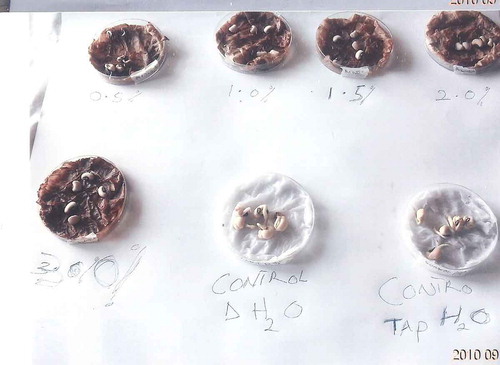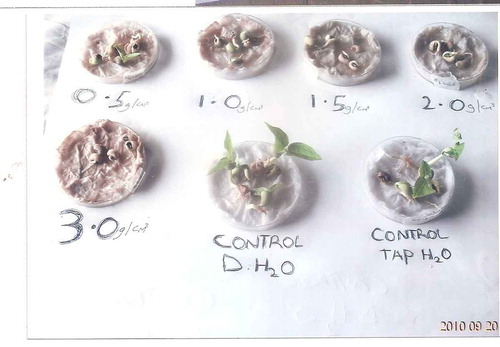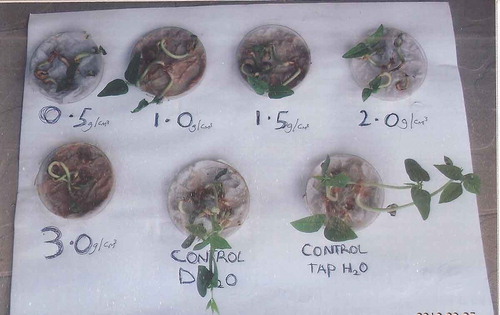Abstract
The effect of leaf and seed extract of nutgrass (Cyperus tuberosus) on the germination of cowpea (Vigna unguiculata (L.) Walp) was investigated at the microbiology laboratory of the Science Laboratory Technology Department, Federal Polytechnic Mubi, using six aqueous extracts: control (0.0 g cm−3), 0.5, 1.0 1.5, 2.0, and 3.0 g cm−3. The experiment was laid out in a completely randomized design replicated three times. Results revealed that the aqueous leaf extract had more toxic effect on the germination of cowpea seed especially at the 3rd day to 9th day of germination. The concentration 1.0 g cm−3 gave a significant (p ≤ 0.05) effect in the last 5 days of the germination experiment and is a better germination, while the higher concentration 3.0 g cm−3 had recorded barely no germination at all from day 1 to day 13 of the experimental period. Bioassays also indicate that the inhibitory effect was proportional to the concentrations of the extracts that is the higher the concentration the stronger inhibitory effect, whereas the lower the concentration the lower stimulatory effect in some cases. This investigation therefore comparatively reveals that the leaves extract of C. tuberosus has more allelopathy than seed extract.
Public Interest Statement
This research work was carried out during the year 2010 with a view to assessing the effect of allelopathy in the field that probably the bean (Vigna unguiculata (L.) Walp) seeds may experience in the course of germination. A laboratory experiment was conducted using the extracts with varying bioassay concentrations from both root and leaves of Cyperus tuberosus L. which is a common weed that inhibit the soils of low fertility, and where most common legumes such as field bean are grown in the tropical dry savannahs of Nigeria. The corresponding author, a lecturer, provided material and design of the study while the co-author, a student, conducted the laboratory work, and draft of the paper. Laboratory facilities at the science laboratory Technology Department of Federal Polytechnic, Mubi was adequate to complete this research. It is our hope that the results from this work can equally translate to the conditions in the field.
Competing interests
The authors have no competing interests in this research and article write-up.
1. Introduction
Certain weed species tends to influence the performance of cultivated crops by exerting positive or negative effect on their germination and subsequently growth. Allelopathy is defined as the detrimental effect of chemicals or exudates produced by one plant species on the germination, growth, or development of plant species, sharing the same habitat. Many crops and roots residues have been reported to have allelopathic effect on agricultural plants (Whittaker & Feeny, Citation1971). A lot of study has been carried out on the effects of chemicals released by roots, leaves, fruits, and other parts of growing plants on the growth of another species (Rice & Elroy, Citation1984). Plants may influence the growth of each other by means of exudates, leachates from decomposing residues, and residues incorporated into growing medium. Price et al. (Citation2008) demonstrated that the exudates from tropical weeds inhibited the growth of Yam in a manner similar to yield reduction when yams are grown in full competition with weeds. Allelopathy is also a biological phenomenon in which one or more biochemical produced influences the growth, survival, and reproduction of other organism. Weeds species are considered as rich source of secondary metabolites (allelochemicals) and these chemicals modify the environmental system on other plants growing in their vicinity and the phenomenon is known as allelopathy (Nandal, Birla, Narwal, & Koushik, Citation1994). These biochemicals are known as allelochemicals and can have beneficial (Positive allelopathy) or detrimental (negative allelopathy) effect on the target organisms. Willis and Ricks (Citation2007) explained that allelochemicals are a subset of secondary metabolites, which are not required for metabolism (i.e. growth, development and reproduction) of the allelopathic organism and the allelochemicals with negative allelopathic effect are an important part of the plant.
Nutgrass (Cyperus tuberosus) is a noxious perennial weed of cultivated fields’ crops of warmer regions of the world (including Nigeria) (Hauser, Citation1971). It is adapted to a variety of soil types varying from crop fields to nurseries. It is common and prevalent in the agricultural fields of Adamawa state and affects cowpea yield which is among the major crops grown, thereby bringing economic loss to farmers. However, little is known about the effects of the weed by farmers who constitutes majority of the population. It is in this regard that this experiment was conducted to determine the allelopathic effect of C. tuberosus on the germination cowpea with the view of determining its positive and negative effect. However, by the farmers who constitutes majority of the population and do not seem to understand the effect of these weed/crop association.
2. Materials and method
The study was conducted in the microbiology laboratory unit of the Science Laboratory Technology Department of Federal Polytechnic, Mubi (Latitude 10° 15′ N and Longitude 13° 16′ E at an altitude of 696 m above sea level). The climate is characterized by alternating dry and wet season. Rainfall last from April to October with mean annual rainfall of 700–1,050 mm (Adebayo, Citation2004; Udo, Citation1970).
Fresh sample of nutgrass (C. tuberosus) was collected from Teaching and Research farm, Federal Polytechnic Mubi. Both leaves and roots of C. tuberosus were collected and the seeds were removed from the roots of the plant and washed with running tap water, then rinse with distilled water. The leaves were dried in the oven at 80°C for 24 h. The dried samples were then ground to powder form, the seeds on the other hands were dried under the sun for two days and the powder form prepared following the former procedure. Powders obtained were sieved with 8.0 mm size wire mesh and larger particles removed. The fine particles were weighed into: 50, 100, 150, 200, and 300 g. And then dissolved into 100 cm3 of distilled water and left for 24 h these were then filtered using funnel and muslin cloth into conical flasks to form concentrations: control (0.0 g cm−3), 0.5, 1.0, 1.5, 2.0, and 3.0 g cm−3 seed extract were also prepared following the same procedure. The concentrations with distilled water as control in each were then applied into 36 Petri dishes which contained sterilized cotton wool with five seeds of cowpea each in a completely randomized design with three replications. The experiment was run for 13 days after which it was terminated. Data were taken based on germination count, radical, and plumule lengths. Characters measured were subjected to analysis of variance using SAS system for windows (SAS, V8, Citation2000). Means showing significant effect were separated using the least significant difference at 5% level of probability (Little & Hills, Citation1978).
3. Results
The allelopathic effect of C. tuberosus seed extract on the germination of cowpea is presented in Table . There was a significant (p ≤ 0.05) difference between treatments from the first day to the fourth day of germination, and subsequently at 5th and 6th days of germination, except at 0.5 g cm−3 which did not differ significantly (p ≥ 0.05) with the control (0.0 g cm−3). Similarly, the control did not differ significantly (p ≥ 0.05) with treatments at 7th day of germination to the 13th day except with 2.0 and 3.0 g cm−3 which differ significantly with the control. The least allelopathic effect of the seed extract was 0.5g cm−3 at the 7th day of germination to the 13th day of germination with 99.66% germination, while the highest allelopathic effect was observed at the highest concentration 3.0 g cm−3 at the 1st and 2nd days of germination with 0.00% germination.
Table 1. Effect of C. tuberosus leaf and seed extract on the germination of beans from day 1 to day 6
Table also presents the allelopathic effects of C. tuberosus leaf extract on the germination of beans (Plate ). The highest concentration of leaf extract 3.0 g cm−3 had no significant (p ≥ 0.05) differences with other treatments at the 1st to the 5th day of germination, and at the 8th to the 10th day of germination. But differ significantly (p ≤ 0.05) to other treatments at the 5th day of germination to the 7th day, and at 11th to 13th days of germination. There was also no significant (p ≥ 0.05) difference between 0.5 g cm−3 and the control at the 4th to 13th days of germination. However, there was a significant (p ≤ 0.05) allelopathic effect of the leaf extract at all levels of the treatments (1.0–3.0 g cm−3) from the 1st to the 13th day of germination. Similarly, at 1.0 g cm−3, allelopathic effect dropped drastically as compared to 0.5 g cm−3, and the control (0.0 g cm−3). The highest mean allelopathic effect was noticed with 1.5 g cm−3 recording 6.60% at the 1st day of germination, while the least allelopathic effect was noticed on extract concentration of 0.5 g cm−3 recording 100% between the 6th day of germination to the 13th day of germination (Plates and ).
Table 2. Effect of C. tuberosus leaf and seed extract on the germination of beans from day 7 to day 13
4. Discussion
The effect of nutgrass (C. tuberosus) seed aqueous extract on the germination of cowpea might not be unconnected to the ability of some grasses to manifest its allelopathic effect on the germination and growth of crops. An earlier study has shown that Acacia auriculiformis affects seed germination of some agricultural crops. Similarly, the allelopathic effect of Bambusa arundinaceous on Arachis hypogea was also reported (Eyini, Joyakumar, & Pannireselvam, Citation1989) this also confirms the findings of Mousari and Al Naib (Citation1975) on the inhibition of seed germination of some herbaceous plants by leaf extract of Eucalypt. It was also observed that the leaf extract of Acacia auriculiformis delayed as well as hindered the germination in plants (Rafiqul Hoque, Ahmed, Uddin, & Hossain, Citation2003). Evanari (Citation1994) noted that the presence of germination inhibitors is a widespread phenomenon, while the detrimental effect of chemical exudates from growing plant can be directly related to their environmental product of decay or dead plant tissue as part of the inert non-living component of the ecosystem. The inhibitory effect increases with an increase in the extract concentration (Rafiqul Hoque et al., Citation2003). It has also been reported that a decrease in phytotoxicity was observed with increasing age of residue (Batish, Singh, Pandher, & Kohli, Citation2005). Allelochemicals are subject to various biotic and a biotic processes that reduce their persistence, concentrations, availability, and biological activities after they are released into the soil. Such processes embody utilization by soil micro-organisms (Blum, Shafer, & Lehman, Citation1999), chemical transformation (Okumura, Filonow, & Waller, Citation1999), and polymerization (Wang, Huang, Chou, & Chen, Citation1986) among others. Allelopathic potential vary from plant to plant (Adler & Chase, Citation2007; Batish, Singh, Rana, & Kohli, Citation2006; Brennan & Smith, Citation2005; Hong et al., Citation2003; Price et al., Citation2008; Reeves, Price, & Patterson, Citation2005; Stoll, Price, & Jones, Citation2006). Rice and Elroy (Citation1984) inferred that chemicals that inhibit the growth of some species at certain concentration could stimulate the growth of the same or different species under lower concentration.
5. Conclusion and recommendations
Aqueous concentrations of leaf and seed extract of nutgrass (C. tuberosus) were used in determining its allelopathic effect on germination of cowpea. This study has shown that the leaf extract of C. tuberosus has more allelopathy than its seed extract. Based on the result obtain from this research on the allelopathic, it can be concluded that the allelochemicals released by C. tuberosus water extract of both leaf and seeds have no adverse effect on the germination cowpea.
It is recommended that further research should be carried out to investigate the effect of this weed plant, C. tuberosus on the germination of different of crop in the study area. It is further recommended that farmers should take appropriate care on some of the weed plant that may cause damage to their crops on the farms by land preparation, ploughing, harrowing ridging and proper sanitation to minimize expenses.
Acknowledgement
We wish to thank the management of Federal Polytechnic, Mubi and particularly the Department of Science laboratory technology for allowing the use of facilities in their laboratories, and also acknowledge the permission of the department of Agricultural technology, federal polytechnic Mubi for collecting weed samples of Cyperus tuberosus from their farms.
Additional information
Funding
Notes on contributors
Mustapha Dauda Belel
The authors of this article are related by blood. The corresponding author Mustapha Dauda Belel was born 44 years ago and had obtained BSc and MTech at the prestigious Federal University of technology Yola. He works as a lecturer at the Federal Polytechnic, Mubi.
Rahimatu Dauda Belel
The second author Rahimatu Dauda Belel is a lady of age 26 years and studied HND (chemistry) at the Federal Polytechnic, Mubi. Currently, she works with the Adamawa state primary health care development agency as a heath laboratory technician.
References
- Adebayo, A. A. (2004). Mubi region, A geographical synthesis ( 1st ed., pp. 17–25). Yola: Paraclate.
- Adler, M. J. , & Chase, C. A. (2007). Comparison of the allelopathic potential of leguminous summer cover crops: Cowpea, sunn hemp, and velvet bean. Hortscience , 42 , 289–293.
- Batish, D. R. , Singh, H. P. , Pandher, J. K. , Kohli, R. K. (2005). Allelopathic interference of Parthenium hysterophorus residues in soil. Allelopathy Journal , 15 , 267–273.
- Batish, D. R. , Singh, H. P. , Rana, N. , & Kohli, R. K. (2006). Assessment of allelopathic interference of Chenopodium album through its leachates, debris extracts, rhizosphere and amended soil. Archives of Agronomy and Soil Science , 52 , 705–715.10.1080/03650340601037119
- Blum, U. , Shafer, S. R. , & Lehman, M. E. (1999). Evidence for inhibitory allelopathic interactions involving phenolic acids in field soils: Concepts vs. an experimental model. Critical Reviews in Plant Sciences , 18 , 673–693.10.1016/S0735-2689(99)00396-2
- Brennan, E. B. , & Smith, R. F. (2005). Winter cover crop growth and weed suppression on the central coast of California. Weed Technology , 19 , 1017–1024.10.1614/WT-04-246R1.1
- Evanari, M. (1994). Germination inhibitors. Botanical Review , 13 , 153–194.
- Eyini, M. , Joyakumar, M. , & Pannireselvam, S. (1989). Allelopathic effect of bamboo leaf extracts on the seedling of groundnut. Tropical Ecology , 30 , 138–141.
- Hauser, E. W. (1971). Nutsedge. A worldwide plague. Weed Today , 2 , 21–23.
- Hong, N. H. , Xuan, T. D. , Eiji, T. , Hiroyuki, T. , Mitsuhiro, M. , & Khanh, T. D. (2003). Screening for allelopathic potential of higher plants from Southeast Asia. Crop Protection , 22 , 829–836.10.1016/S0261-2194(03)00051-6
- Little, T. M. , & Hills, R. H. (1978). Agricultural experimentation design and analysis . New York, NY: Wiley.
- Mousari, A. H. , & Al Naib, F. A. G. (1975). Allelophatic effect of Eucalyptus microtheca F. Muell. Journal of University of Kuwait (Science) , 2 , 59–66.
- Nandal, D. P. S. , Birla, S. S. , Narwal, S. S. , & Koushik, J. C. (1994). Allelopathic interactions in agroforestry systems. In Allelopathy in agriculture and forestry (pp. 93–130). Jodhapur: Scientific Publishers.
- Okumura, M. , Filonow, A. B. , & Waller, G. R. (1999). Use of 14C-labeled alfalfa saponins for monitoring their fate in soil. Journal of Chemical Ecology , 25 , 2575–2583.10.1023/A:1020886527371
- Price, A. J. , Stoll, M. E. , Bergtold, J. S. , Arriaga, F. J. , Balkcom, K. S. , Kornecki, T. S. , & Raper, R. L. (2008). Effect of cover crop extracts on cotton and radishradicle elongation. Communications in Biometry and Crop Science , 3 , 60–66.
- Rafiqul Hoque, A. T. M. , Ahmed, R. , Uddin, M. B. , & Hossain, M. K. (2003). Allelophatic effect of different concentration of water extract of Acacia auriculiformis leaf on some initial growth parameters of five common agricultural crops. Pakistan Journal of Agronomy , 2 , 92–100.
- Reeves, D. W. , Price, A. J. , & Patterson, M. G. (2005). Evaluation of three winter cereals for weed control in conservation-tillage nontransgenic cotton. Weed Technology , 19 , 731–736.10.1614/WT-04-245R1.1
- Rice, E. , & Elroy, L. (1984). Allelophaty (1st ed., 422 p.). Sandiego, CA: Academic Press. ISBN 978-0125870508.
- SAS . (2000). System for windows . ( Version 8). Cary, NC: SAS Institute.
- Stoll, M. E. , Price, A. J. , & Jones, J. R. (2006, June 26–28). Cover crop extracts effects on radish radicle elongation . Paper presented at Southern Conservation Systems Conference, Amarillo, TX.
- Udo, R. K. (1970). Geographical regions of Nigeria (1st ed., pp. 195–197). London: Heinemann.
- Wang, T. S. C. , Huang, P. M. , Chou, C. H. , & Chen, J. H. (1986). The role of soil minerals in the abiotic polymerization of phenolic compounds and formation of humic substances. In P. M. Huang & M. Schnitzer (Eds.), Interactions of soil minerals with natural organics and microbes ( SSSA Special Publication Number 17, pp. 251–281). Soil Science Society of America . Madison, WI.
- Whittaker, R. H. , & Feeny, P. P. (1971). Allelochemics: Chemical interactions between species. Science , 171 , 757–770.10.1126/science.171.3973.757
- Willis, D. , & Ricks, J. (2007). The history of allelopathy . Springers. Retrieved from http:/www.google.comoo. ISBN 1402092x.



